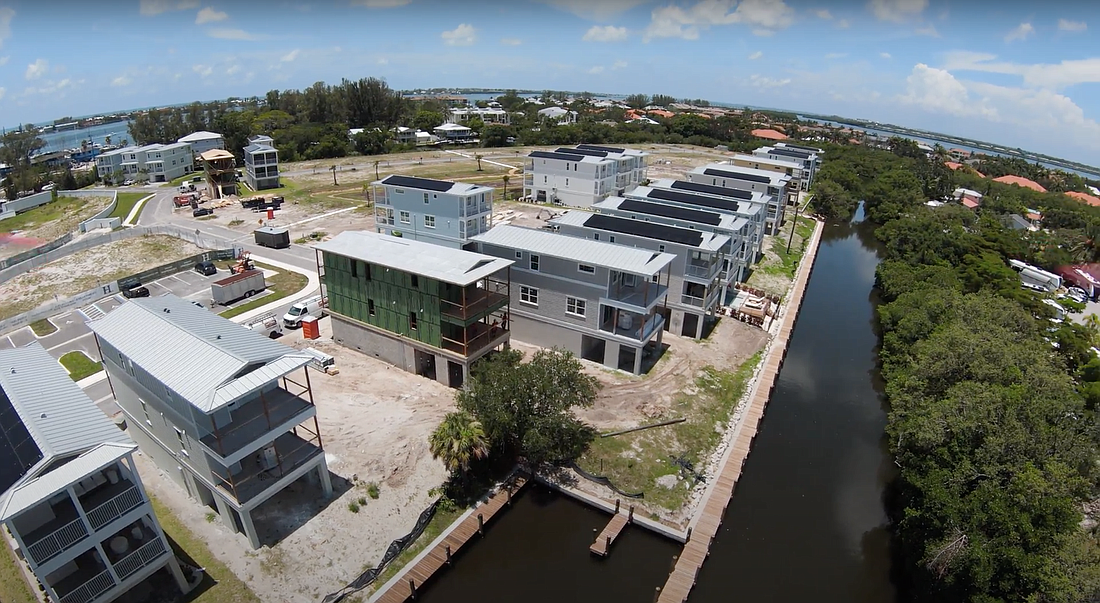- July 26, 2024
-
-
Loading

Loading

A win for sustainability is in the books after Bradenton-based Pearl Homes was recognized by the U.S. Green Building Council as a 2023 LEED Power Builder for building a community that developer Marshall Gobuty believes will soon set the standard for sustainability in the homebuilding industry.
The recognition comes a few years after that community — Hunters Point — was just getting started. Gobuty, president and founder of Pearl Homes, and his team started working on Hunters Point in Cortez, an Old Florida fishing village in west Manatee County off of Sarasota Bay, in 2017. The 86-home community, with homes ranging in price from $1.49 million to $1.89 million, generates more energy than is consumed.
It’s been a lot of research, design, development and starting over, for not all of the model homes built were winners at first. Gobuty says the team had completed a home in the center that was eventually scrapped because the home wasn’t big enough for what consumers sought. It was 600 square feet too small. The team revised calculations and had the home design in six months.
“It was hard,” he says. “None of this is easy. But it is gratifying.”
The concept is a house that runs entirely on solar panels that are connected to a Sonnen battery, which is roughly the size of a refrigerator. The house generates more power than is consumed, thus eliminating a utility bill.
The company built a model home in a research and design center in Palmetto to monitor its performance for 18 months. After three months of operation, Gobuty says the house exceeded power generation. Now that people are living in the houses, that proof is tenfold.
“We can tell in one month we had 1,800 pounds of CO2 that we did not put out into the environment,” Gobuty says, adding that's the same as the amount of air 14 trees can generate in a month. And according to the Arbor Day Foundation, it would take a year for 37.5 mature trees to absorb that much carbon dioxide from the environment.
Data collected that Gobuty provided shows that a net-positive pearl home exports 8,000 kilowatts per hour back to the grid. For perspective, one kilowatt per hour equals the amount of energy it takes to run a 1,000-watt appliance for an hour.
Gobuty, who refers to the U.S. Green Building Council as the “people who invented sustainability,” revels in the organization's recognition, which is awarded to developers and builders committed to LEED and residential green building.
“For them to say we do a good job,” he says, “it means something.”
But just because Pearl Homes is a Power Builder doesn’t mean Gobuty’s work is done. Really, he’s just getting started because now he’s focused on taking what he’s learned from creating a net-zero home and perfecting it. He wants to apply the concept to multifamily units.
“We’ve already proven that the model works,” he says. “It’s just applying it to different residential opportunities.”
Pearl Homes is currently working on a workforce housing community in downtown Bradenton named the Met that will begin leasing in the third quarter. Through the use of on-site battery storage technology and solar panels, the project will bring 200 sustainable units to the area, he says.

Then it’s onto the Met 2, also referred to as the Epic. The idea of this project is to create net zero multifamily housing, but on less than an acre to prove sustainable living can be achieved within cities. The two-bedroom units are being developed with battery and solar power on-site. The nearly 30 units should be underway in the next six months, Gobuty says.
More sustainability? Earlier this year Pearl Homes purchased 120 acres between Ellenton and Parrish in north Manatee County for 720 single-family rentals, which will be sustainable with market-rate rents, within a community called Ourlives.
While building these communities are a welcome addition to the area, Gobuty says the biggest contribution he can make is getting homebuilders on a national scale to get onboard.
“We’ve had builders come from everywhere to see how we do it,” he says, noting that local homebuilders aren’t buying into the concept — yet. “It’s not as expensive as you think. I believe this is the future of home owning.”
Gobuty says after tax credits, the solar and battery system adds about $58,000 to the cost of each home.
Over the last two months, Gobuty says he’s seen more positive movement amongst homebuilders who have come to talk to him about it. At first, “they just look at you like you’re crazy,” he says. Having results after the first quarter of people living in the homes has helped.
“So we’re not just saying the model worked,” he says. “We’re actually showing hard numbers.”
On Aug. 1, he met with a company that owns hotels and Amazon buildings who was interested in how they can apply the concept to their business.
“I really think that it only takes two or three big (companies) to blow this up into a standard,” he says. “I think we’re close.”
This story has been updated to correct the per-unit cost of the solar and battery system.